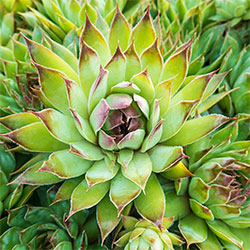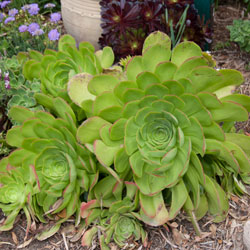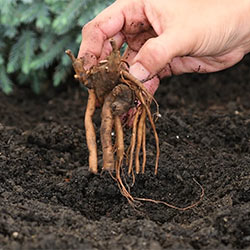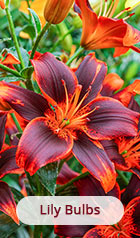
Succulents
Succulent Care Guide
Succulent plants are a versatile addition to any garden due to their low maintenance, varied and highly-textured aesthetic. From classic Hens and Chicks to trend-worthy rosette styles, succulents can add life to any potted arrangement and work beautifully as ground cover. Growing succulent plants is easy-just make sure you set them up for success. Continue reading to learn more about succulent plant care.
About Succulents
"Succulent" is not the name of a genus or family, but a descriptor of several types of plants. Succulents are drought-tolerant plants that are characterized by their tough exterior and their ability to store water in their leaves and stems. Aloes, cacti, and echeverias are all succulents, and share a hardy, sun-loving nature and ability to grow well in rocky, dry climates.
Succulents have long been beloved by fans of xeriscaping, or irrigation-free gardening, as well as gardeners in naturally dry climates. Recently, succulents have taken off in popularity as indoor houseplants, bouquet mix-ins, and table decor. They are able to thrive as house plants, provided that they can be placed in a sunny location and a well-drained container.
Types of Succulents
A huge category of plants, succulents grow in a vast array of shapes and sizes. Due to their shallow root systems most succulents tend to be relatively low-lying, growing a host of short stems or fanning out into a rosette shape. Let's look at a few of our favorite succulents!
Hens and Chicks

Hens and chicks are known for their colorful appearance and rosette design. The larger rosettes are known as the hens, and the smaller rosettes encapsulated by them are called chicks. This variety of succulent flourishes in rock gardens or containers. Hens and chicks are considered to be a low-growing perennial that can spread up to two feet, making an excellent
groundcover. Hens and chicks thrive in sandy or well-drained soil. When planting, they should be watered well but after they are settled in they can be watered less frequently.
Sedum

Sedum are a very forgiving variety of succulents, ideal for beginning gardeners. Most sedum are sprawling plants, growing outward with multiple stems and star-shaped flowers. Sedum also grow in a variety of colors, including green, red and purple. These hardy perennials vary in size based on the variety, but can range anywhere from a few inches to 3 feet. A "carpet" of sedum makes a stunning ground cover, or can fill a planter! Sedum require very little water or fertilizer, and may even be damaged in the case of excessive care, so don't overwater your sedum.
Rosette Succulents

Rosette succulents include multiple species that have leaves resembling an open rose or lotus. Aloe, Echeveria, Haworthia, and Aeonium fall into the rosette category, and Greenovia dodrentalis actually looks like an opening rose. Rosette succulents, like all others succulents, perform best in mild climates with limited rainfall. These plants prefer just a bit more watering, and they won't withstand cold temperatures. If you grow rosette succulents outdoors, they should be brought indoors during the winter months.
How to Care for Succulents
Succulents are among the easiest plants to take care of-in fact, too much care can render them unhealthy, so water them sparingly. Aside from leaving your succulents alone, here are some tips for ensuring proper care of succulent plants:
- If you're gardening from a planter, choose your growing container wisely: succulents should be planted in a pot with proper drainage. Terra cotta pots are typically good choices for beginner gardeners. If you want to use a designer pot, use a well-draining pot, such as a nursery pot, inside.
- Ensure proper soil type. Regardless of the exact type of soil, all succulents will benefit from well-draining soil, so they will not be over-watered. If you're growing your succulents outdoors, mix sand or loam into your planting space to keep your soil from becoming too rich.
- Water your soil directly, using a hose, pipette, or watering can. Misting or spraying the leaves can allow rot to set in.
- When moving potted succulents outdoors for the season, acclimate your succulents to their environment slowly. Most succulents like about six hours of sunlight daily, but can get sunburnt easily. Be sure to avoid placing your succulents in the direct sun on hot days, making sure they get some time in the shade as well.
- Overwatering is a very common problem with succulent plants. Learning how to properly water succulents is a key part of mastering succulent care. Unlike other houseplants and perennials that want consistently moist soil, succulents cannot tolerate being overwatered. You should only water your succulents after the soil has been completely dry for a few days.
Succulent Pests and Disease Prevention
Succulents are less likely than moisture-loving plants to develop gnat infestations or mold. However, just like any other plant, succulents sometimes experience issues with pests and fungus. Read on for some of the common issues and fixes for pests and problems in succulents.
Mealybugs
Mealybugs appear on the stems of succulents-you'll see small, fuzzy substances coating the spots where the stems meet the leaves. They require immediate action or they will spread and quickly affect the entire succulent plant, mealybugs also discharge a sweet substance that attracts ants. The best way to avoid mealybugs is to maintain a clean and dry area around your succulent. If you do end up with mealybugs, remove the plant from the pot and wash it under a hearty spray of water. You should also thoroughly rinse the pot with soap and water before repotting with new soil.
Mice
If grown outdoors, juicy succulents may be sought out by mice and other animals as a tasty snack. Unfortunately, succulents damaged by animals will not be able to grow properly, as their energy will be expended healing. Try using commercial animal deterrents, or enclose your succulents with wire mesh so that rodents will not have direct access to them.
Rot
Rot occurs when plants are living in cold or damp settings which allows bacteria and fungi to develop. Monitor how often you water succulents to prevent rot from occurring. If you notice that any parts of your succulents are rotting (rot usually starts at the root and is marked by a slimy appearance or foul odor), immediate action is necessary. The best way to tackle rot is to cut off all of the infected regions of the plant. If rot is found early enough, you can propagate the plant to encourage new plant growth.
Be sure to check out our
tips for foolproof gardening page for more information on achieving success in your garden!
Have another question? Return to the Customer Service Help page or send an e-mail directly to Customer Service

























